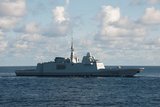How anti-jam technology is helping provide resilience for Global Navigation Satellite Systems (Sponsored)
The Tualaj Anti-Jam GPS/GNSS CRPA Product Family. (Image: Tualcom)
This article is brought to you by Tualcom
The power level of the GNSS satellite signals on Earth is well below the noise floor, which makes those signals vulnerable to intentional or unintentional RF interference. Military operations in recent years have shown that many platforms used in the tactical field are under a clear threat of GPS/GNSS jamming and spoofing.
TUALCOM is dedicated to provide resilience to systems/platforms with GNSS against jamming. R&D-driven design and development processes have led to the most advanced AntiJam solutions and the most diverse product family for all kinds of requirements and platforms.
CRPA Technology and Beyond
Superior in-house engineering capabilities have helped develop a state-of-the-art digital antenna control unit (DACU) to elevate the commonly used Controlled Reception Pattern Antenna (CRPA) technology for jamming suppression to another level. The proprietary DACU is easily configured to control beams of 2, 4 or 8 antennas to allow the world’s most versatile and diverse antijam product family to be offered off-the-shelf, conforming to all size, weight, power and cost requirements.
At TUALCOM we prefer to call our products Customized-Off-The-Shelf (C-OTS) to indicate our commitment and ability to provide tailor made solutions to our customers’ needs should the selected off-the-shelf product is not 100% match to the needs. The most prominent features of TUALAJ Anti-Jamming GNSS product family are,
- Ability to work with multiple constellations – TUALAJ family has the ability to work with multiple constellations and depending on the selected product, protection for up to three different GNSS bands, namely, GPS (L1, L2), GLONASS (G1, G2), Galileo (E1), and BeiDou (B1) simultaneously, is provided.
- Ultra-Low SWaP - For platforms with space limitations, TUALCOM provides the smallest, lightest, and fully performing jam-free solutions. While the integrated DACU-CRPA structure helps achieving Ultra-Low SWaP features, the performance is never compromised providing resilience against up to 7 jamming sources.
- Easy integration – TUALAJ products can easily be integrated into platforms via a digital connector and RF cables between the antenna array and DACU.
- Embedded GNSS receiver option – Although TUALAJ products could be used together with existing GNSS receivers, there is also an internally integrated GNSS receiver option ideal for applications with the strictest space and power limitations.
With these features, TUALCOM’s GNSS AntiJam systems have been deployed on more than 10 different maritime and air platforms and their performance has been improved with lessons learned from the tactical field. This is the main reason TUALCOM has sold more than 3,000 AntiJam Systems within the last 12 months worldwide.
Learn more here.
More from Industry Spotlights
-
![The future is here: Sixth-gen air dominance]()
The future is here: Sixth-gen air dominance
How RTX is equipping the military airspace – for today’s fleet and tomorrow’s fight.
-
![De-Risking the Future: Manufacturing Certainty for Unmanned Systems]()
De-Risking the Future: Manufacturing Certainty for Unmanned Systems
How strategic manufacturing partnership solves the industrialisation triad — Scale, Compliance and Cost — for hyper-growth defence tech innovators.
-
![Battlefield mobility, made in the UK]()
Battlefield mobility, made in the UK
How does Britain ensure that we can preserve the lives of our soldiers and allies – now and in the future – with homegrown innovation and resilient domestic manufacturing? At Pearson Engineering, we are proud to be a central part of the answer to this increasingly important question.
-
![Strengthening Baltic defence capabilities]()
Strengthening Baltic defence capabilities
How Latvia is bolstering its territorial defences, industrial capacity and international cooperation with Dynamit Nobel Defence’s SKORPION2 Remote Mining System.
-
![Barco’s vision to trust: from past to future]()
Barco’s vision to trust: from past to future
Barco’s story is one of constant evolution enabling more immersive, reliable, and future-ready training experiences.
-
![How are next-generation ejection seats helping pilots when they need it most?]()
How are next-generation ejection seats helping pilots when they need it most?
The ACES 5 ejection seat from RTX’s Collins Aerospace introduces new, innovative and patented technologies to help save lives.




























